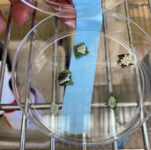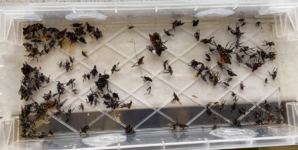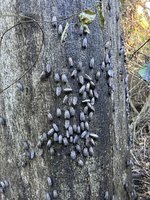I've started to see spotted lanternflies en masse in my yard. They seem to have invaded NY. Thoughts on the dangers of these pests to our trees and how to deal with them? I've been searching for egg casings on my trees and killing any of the buggers I can find.
You are using an out of date browser. It may not display this or other websites correctly.
You should upgrade or use an alternative browser.
You should upgrade or use an alternative browser.
Spotted Lanternfly
- Thread starter dbonsaiw
- Start date
bdmatt
Mame
I did a year and a half of biological control research dealing with spotted lantern flies (SLF) at my university UCR. My job was to raise SLFs, maintain the trees used to rear them, and experiment what trees they attacked. One division at my research studied the effects of SLF on important agriculture products; we note that they devastate grapes, pistachios, cherries, avocados, plums, and blue berries (oranges may be at risk but not conclusive).
Near the end of my research, I tested out species we used commonly in bonsai. They are extremely dangerous pest to our trees. They attack elms, cork oaks, maples (JM and american species), some pines, birch, bougainvillea, and beech. These are the only ones we tested. Nymphs are also noted to have a wider range of target hosts, including perennials and roses.
They feed from the sap and lay their eggs on the bark of host trees. You'll find your trees slowly fade in color as they weaken from hundreds/thousands of SLF sucking away at the sap.
We are currently still developing methods to deal with SLF but they are so damn prolific it's difficult to manage them. A promising way to dealing with SLF are parasites and parasitoids such as anastatus japonicus. However, for our trees in bonsai, the best way to deal with them for now is prevention. Keep your trees healthy and use pesticides as you would any other pest. Check up on trees surrounding your home, especially ailanthus. SLF (at all stages of their life cycles) thrive when ailanthus is present. Also report any SLF you find to proper local authorities. They are confirmed in Pennsylvania and surrounding states but are slowly spreading westward.
Near the end of my research, I tested out species we used commonly in bonsai. They are extremely dangerous pest to our trees. They attack elms, cork oaks, maples (JM and american species), some pines, birch, bougainvillea, and beech. These are the only ones we tested. Nymphs are also noted to have a wider range of target hosts, including perennials and roses.
They feed from the sap and lay their eggs on the bark of host trees. You'll find your trees slowly fade in color as they weaken from hundreds/thousands of SLF sucking away at the sap.
We are currently still developing methods to deal with SLF but they are so damn prolific it's difficult to manage them. A promising way to dealing with SLF are parasites and parasitoids such as anastatus japonicus. However, for our trees in bonsai, the best way to deal with them for now is prevention. Keep your trees healthy and use pesticides as you would any other pest. Check up on trees surrounding your home, especially ailanthus. SLF (at all stages of their life cycles) thrive when ailanthus is present. Also report any SLF you find to proper local authorities. They are confirmed in Pennsylvania and surrounding states but are slowly spreading westward.
JackHammer
Chumono
Wow, you have a cool background. Thanks for sharing. I am about 50 miles east of PA in Ohio and I saw 2 this past spring but I didn't know they were invasive at the time but I am almost positive that's what I saw.I did a year and a half of biological control research dealing with spotted lantern flies (SLF) at my university UCR. My job was to raise SLFs, maintain the trees used to rear them, and experiment what trees they attacked. One division at my research studied the effects of SLF on important agriculture products; we note that they devastate grapes, pistachios, cherries, avocados, plums, and blue berries (oranges may be at risk but not conclusive).
Near the end of my research, I tested out species we used commonly in bonsai. They are extremely dangerous pest to our trees. They attack elms, cork oaks, maples (JM and american species), some pines, birch, bougainvillea, and beech. These are the only ones we tested. Nymphs are also noted to have a wider range of target hosts, including perennials and roses.
They feed from the sap and lay their eggs on the bark of host trees. You'll find your trees slowly fade in color as they weaken from hundreds/thousands of SLF sucking away at the sap.
We are currently still developing methods to deal with SLF but they are so damn prolific it's difficult to manage them. A promising way to dealing with SLF are parasites and parasitoids such as anastatus japonicus. However, for our trees in bonsai, the best way to deal with them for now is prevention. Keep your trees healthy and use pesticides as you would any other pest. Check up on trees surrounding your home, especially ailanthus. SLF (at all stages of their life cycles) thrive when ailanthus is present. Also report any SLF you find to proper local authorities. They are confirmed in Pennsylvania and surrounding states but are slowly spreading westward.
I heard they like tree of heaven which is also invasive (ironic).
On the plus side, we did not get swarms of stink bugs this year which was nice. Plenty of Japanese beetles though. :/
Tieball
Masterpiece
Spotted Lantern Flies. Something new for me to watch for around the area. I have not seen any yet. Perhaps they don’t live long enough with my lengthy frigid winters.
bdmatt
Mame
Thank you! Every time I see a tree of heaven, I get flashbacks to SLF haha.Wow, you have a cool background. Thanks for sharing. I am about 50 miles east of PA in Ohio and I saw 2 this past spring but I didn't know they were invasive at the time but I am almost positive that's what I saw.
I heard they like tree of heaven which is also invasive (ironic).
On the plus side, we did not get swarms of stink bugs this year which was nice. Plenty of Japanese beetles though. :/
Speaking of stink bugs, we also did research on BMSB. Lots of promising research on them as well. Trissolcus japonicus is extremely effective in targeting BMSB eggs and ONLY their eggs. That's huge! Side note, here's a few pictures of how we raised them:


And for anyone curious about what spotted lantern flies look like at their various stages:


No close up photos of the nymphs, but they're pretty distinctive with their white spots.
markyscott
Imperial Masterpiece
They’re here. I took this pictures about a week ago in Sky Meadows State Park - that’s about 2 miles from me as the crow flies. So I’m sure that they’re on my property too. All of the ones I spotted in the park were on ailanthus. I reported the siting to the rangers at the park. Last fall I spotted tons of them on red maples and sugar maples planted as street trees in Winchester.

When we had the land clearing team on our property last year, we had them take down about 60 large ailanthus trees. All of them were on tree lines. It was a lot, but it feels as though we barely made a dent, there are so many Tree of Heaven here in northern Virginia. I’m afraid that this battle is lost before it began. Don’t know what all the vineyards and orchards in the area are going to do.
S

When we had the land clearing team on our property last year, we had them take down about 60 large ailanthus trees. All of them were on tree lines. It was a lot, but it feels as though we barely made a dent, there are so many Tree of Heaven here in northern Virginia. I’m afraid that this battle is lost before it began. Don’t know what all the vineyards and orchards in the area are going to do.
S
We are in a third summer of SLF in South NJ.
1st summer 2021, we had very few; 2nd 2022 in hundreds; this year the numbers are down to 10s. Not sure how to explain it. The winter was mild, but we got an early and abrupt cold snap between Thanksgiving and Chrismas.
In the "wild" on our property they were feeding on trees of heaven, black walnuts and curly willows. Those trees were covered in SLFs and black mold. They were present on grapes, but did no discernible damage to them. They never touched my blueberries.
I think trees of heaven is their natural food.
Maybe if they have what they like they ignore the other stuff.
Trees of heaven are pests here too...
1st summer 2021, we had very few; 2nd 2022 in hundreds; this year the numbers are down to 10s. Not sure how to explain it. The winter was mild, but we got an early and abrupt cold snap between Thanksgiving and Chrismas.
In the "wild" on our property they were feeding on trees of heaven, black walnuts and curly willows. Those trees were covered in SLFs and black mold. They were present on grapes, but did no discernible damage to them. They never touched my blueberries.
I think trees of heaven is their natural food.
Maybe if they have what they like they ignore the other stuff.
Trees of heaven are pests here too...
Gabler
Masterpiece
They're not nearly as destructive as everyone was worried they'd be. Many native pests are much worse. It's not like the emerald ash borers. The ash trees have been completely wiped out around here.
Gabler
Masterpiece
They can't hop away from insecticide. Just spray your trees.
Similar threads
- Replies
- 3
- Views
- 228
- Replies
- 16
- Views
- 1K
